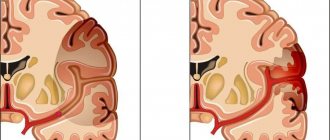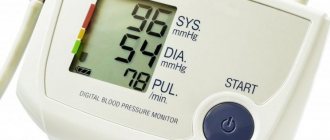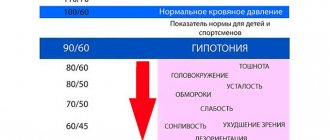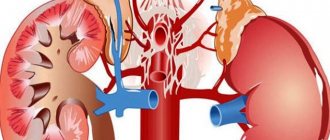What is blood pressure?
Blood pressure is the process of compression of the walls of capillaries, arteries and veins under the influence of blood circulation.
Types of blood pressure:
- upper, or systolic;
- lower, or diastolic.
Both of these values should be taken into account when determining your blood pressure level. The very first units of its measurement remain - millimeters of mercury. This is because older machines used mercury to determine blood pressure levels. Therefore, the blood pressure indicator looks like this: upper blood pressure (for example, 130) / lower blood pressure (for example, 70) mm Hg. Art.
Circumstances that directly affect blood pressure range include:
- the level of force of contractions performed by the heart;
- the proportion of blood ejected by the heart during each contraction;
- resistance of the walls of blood vessels, which is the flow of blood;
- the amount of blood circulating in the body;
- fluctuations in pressure in the chest that are caused by the respiratory process.
Blood pressure levels can change throughout the day and as you age. But most healthy people have a stable blood pressure.
What is blood pressure?
Blood pressure in the vessels of the body is the pressure of the fluid located in the middle of the arteries that distribute blood throughout the body. It realizes the function of blood movement throughout the entire circulatory system and in this way carries out the process of metabolism of important and useful substances in the human body.
What does blood pressure depend on?
- The level of blood pressure (as it is also called blood pressure) depends on:
- on how strongly the heart contracts;
- on the volume of blood that the heart ejects at the time of each contraction;
- from the resistance provided to the flow of blood by the walls of the arteries;
- the pressure inside the arteries is also influenced by the volume of blood flowing in the circle and its density;
- constant changes in pressure inside the abdominal and thoracic regions, interconnected with the breathing process.
Determination of types of blood pressure
Systolic (upper) blood pressure is a characteristic of the general condition of the veins, capillaries, arteries, as well as their tone, which is caused by contraction of the heart muscle. It is responsible for the work of the heart, namely with what force the latter is able to push out blood.
Thus, the level of upper pressure depends on the strength and speed with which heart contractions occur.
It is unreasonable to assert that arterial and cardiac pressure are the same concept, since the aorta also participates in its formation.
Lower (diastolic) pressure characterizes the activity of blood vessels. In other words, this is the blood pressure level at the moment when the heart is most relaxed.
Lower pressure is formed as a result of contraction of the peripheral arteries, through which blood enters the organs and tissues of the body. Therefore, the state of blood vessels – their tone and elasticity – is responsible for the level of blood pressure.
Kinds
There are 4 types:
- Systolic (upper). Reflects the condition of the myocardium of the left ventricle, veins, capillaries, arteries. It is recorded at the moment of release of blood fluid.
- Diastolic (lower). Fixed when the heart muscle relaxes. Indicates the degree of wall tone.
- Pulse blood. This is the difference between the extreme numbers by which the semilunar valves of the aorta open during ventricular systole.
- The average dynamic value is a constant value. It is calculated by summing the diastolic and 1/3 of the pulse pressure.
How to find out your blood pressure level?
You can find out your blood pressure level using a special device called a “blood pressure tonometer”. This can be done either at the doctor (or nurse) or at home, after purchasing the device at the pharmacy.
The following types of tonometers are distinguished:
- automatic;
- semi-automatic;
- mechanical.
A mechanical tonometer consists of a cuff, a pressure gauge or display, an inflation bulb, and a stethoscope. How it works: put the cuff on your arm, place a stethoscope under it (you should hear your pulse), inflate the cuff with air until it stops, and then begin to gradually deflate it by unscrewing the wheel on the bulb. At some point, you will clearly hear pulsating sounds in the headphones of the stethoscope, then they will stop. These two marks are the upper and lower blood pressure.
A semi-automatic tonometer consists of a cuff, an electronic display and a bulb. How it works: put on a cuff, inflate the bulb to the maximum, then release it. The upper and lower values of blood pressure and the number of beats per minute (pulse) appear on the electronic display.
An automatic blood pressure monitor consists of a cuff, an electronic display and a compressor, which performs manipulations to pump and deflate air. How it works: put on the cuff, start the device and wait for the result.
It is generally accepted that a mechanical tonometer gives the most accurate results. It is also more affordable. At the same time, automatic and semi-automatic blood pressure monitors remain the most convenient to use. Such models are especially suitable for older people. Moreover, some types have a voice notification function for pressure indicators.
You should measure blood pressure no earlier than thirty minutes after any physical activity (even minor) and an hour after drinking coffee and alcohol. Before the measurement process itself, you need to sit quietly for a couple of minutes and catch your breath.
It is not recommended to repeat the procedure using the same hand.
Treatment and prevention of hypertension
Hypertension is terrible for its complications. This could be kidney failure, stroke or heart attack.
A high lower pressure reading most often signals kidney or thyroid disease, and low diastolic pressure is triggered by tuberculosis, atherosclerosis, and anemia. If both upper and lower pressure are elevated, then the problem is heart and vascular disease.
Blood pressure - normal by age
Each person has an individual blood pressure norm, which may not be associated with any diseases.
Blood pressure levels are determined by a number of factors that are of particular importance:
- age and gender of the person;
- personal characteristics;
- life style;
- features of lifestyle (work activity, preferred type of recreation, and so on).
Blood pressure also tends to increase when performing unusual physical activity and emotional stress. And if a person constantly performs physical activity (for example, an athlete), then the blood pressure level may also change both temporarily and for a long period. For example, when a person is stressed, his blood pressure can rise to thirty mm Hg. Art. from the norm.
However, there are still certain limits for normal blood pressure.
And every ten points of deviation from the norm indicates a disruption in the functioning of the body. Blood pressure - normal by age
| Age | Upper level of blood pressure, mm Hg. Art. | Lower blood pressure level, mm Hg. Art. |
| 1 – 10 years | 95 | 60 |
| 10-15 | from 95 to 110 | from 60 to 70 |
| 16 – 20 years | from 110 to 120 | from 70 to 80 |
| 21 – 40 years | from 120 to 130 | from 70 to 80 |
| 41 – 60 years | up to 140 | 90 |
| 61 – 70 years | from 140 to 147 | 85 |
| Over 71 years old | from 147 | up to 85 |
You can also calculate your individual blood pressure using the following formulas:
1. For men:
- upper blood pressure = 109 + (0.5 * number of completed years) + (0.1 * weight in kg);
- lower blood pressure = 74 + (0.1 * number of completed years) + (0.15 * weight in kg).
2. For women:
- upper blood pressure = 102 + (0.7 * number of completed years) + 0.15 * weight in kg);
- lower blood pressure = 74 + (0.2 * number of completed years) + (0.1 * weight in kg).
Round the resulting value to a whole number according to the rules of arithmetic. That is, if the result is 120.5, then when rounded it will be 121.
/ cardiology / An all-Russian study showed that only 23% of Russians have normal blood pressure
Cardiovascular accidents (stroke and myocardial infarction) remain the leading cause of death both in Russia and throughout the world. One of the main conditions leading to the development of cardiac and vascular complications is arterial hypertension. What is arterial hypertension (or, in other words, hypertension)? This is a sustained increase in a patient's blood pressure, when measured by a physician in the office, above 140 (systolic) and 90 (diastolic) millimeters of mercury during at least two visits.
But in addition to the well-known villain hypertension, a significant number of patients experience an initial increase in blood pressure - so-called prehypertension. Prehypertension - a borderline state between optimal blood pressure and arterial hypertension - is defined as systolic from 120 to 139 mmHg and (or) diastolic from 80 to 89 mmHg.
According to the recommendations of the Russian Society of Cardiology from 2008, prehypertension includes the concepts of normal blood pressure (systolic 120-129 mmHg and (or) diastolic 80-84 mm) and high normal blood pressure (systolic 130-139 mmHg and (or) diastolic 85 -89 mmHg).
Table 1 summarizes the norm and degree of increase in blood pressure.
Table 1
| 120/80 | Norm (keep) | |
| Normal blood pressure | 120-129/80-84 | Prehypertension (identify, prevent transition to hypertension) |
| High normal blood pressure | 130-139/85-89 | Prehypertension (identify, prevent transition to hypertension) |
| 1st degree hypertension | 140-159/90-99 | Hypertension (must be treated with non-drug and medicinal means) |
| 2nd degree hypertension | 160-179/100-109 | Hypertension (must be treated with non-drug and medicinal means) |
| 3rd degree hypertension | 180/110 | Hypertension (must be treated with non-drug and medicinal means) |
Why is it important to detect even slightly elevated blood pressure?
According to the Framingham Study (a US sample of more than 5,000 participants was followed for 50 years), 38% of cases progressed to arterial hypertension within four years (Vasan et al. Lancet 2001; 358 (9294): 1682-6). That is, if a person is warned and explained how to prevent a further increase in blood pressure, the development of hypertension and the prescription of pills can be prevented.
In another study of a sample of more than 1 million people aged 40-69 years, each increase in systolic pressure of 20 mm or diastolic pressure of 10 mm above 115/75 mmHg was associated with a twofold increase in cardiovascular mortality (Lewington S. et al. Lancet 2003;361(9362):1060).
How common is prehypertension in the Russian population?
The answer to this question was received recently: the Russian Ministry of Health initiated a study of residents of various regions of Russia to study the characteristics of risk factors for the development of cardiovascular diseases in different regions of Russia. The study was called “Multicenter observational study “Epidemiology of cardiovascular diseases in the regions of the Russian Federation”” (abbreviated ESSE-RF). 13 regions of Russia were taken for observation (with different characteristics - climatic, social, etc.), and in each of them people were randomly selected and invited to take part in the study. That is, among the invitees there were all sorts of people: those who do not seek help from the clinic and do not know anything about their blood pressure, cholesterol levels, blood sugar, and those who know about their health problems.
The most difficult thing was to involve young people in the survey who are busy at work and who have no complaints. But gradually groups that reliably reflected the population by gender and age were formed, and in total more than 22 thousand people throughout Russia took part in the study. The collected data on risk factors - how people often eat poorly, smoke, don’t exercise enough, have obesity and high blood pressure - will allow the Ministry of Health to plan preventive measures, with specifics in each region.
According to the ESSE-RF epidemiological study, the prevalence of prehypertension in the Russian population is 34.1%, and only less than a quarter of the population have an ideal blood pressure level.
Is Russia different from other countries?
The prevalence of prehypertension among the population of different countries of the world is very variable and, when applying unified criteria, according to various authors, is 14.5% in Turkey, 33% in Japan, 36.3% in the USA, 35.7% in China, 58 in Nigeria. .7%.
It turns out that prehypertension is also associated with obesity and metabolic abnormalities (high sugar, cholesterol, diabetes). That is, people with slightly elevated blood pressure often have slightly elevated other risk factors, which cumulatively accumulate and can lead to cardiovascular disaster. It seems to ordinary people that stroke occurs only in those who have very high blood pressure, but this is not true. If you look at the distribution of the frequency of strokes depending on the level of pressure, then normal and high normal account for 31% of all strokes (diagram according to Wolf PA, 2002).
How to prevent even a slight increase in pressure
How to return from prehypertension to normal? Here comes the time to remember the famous expression “One pound of prevention is worth a pound of cure” (to clarify: there are 40 pounds in a pound). That is, the identification of prehypertension should lead to the initiation of preventive measures:
- reduce body weight: losing weight by 1 kg reduces blood pressure by 1 mmHg and the risk of stroke by eight times;
- limit salt and fluid intake - yes, people with high blood pressure should consume no more than 6 g of salt per day and drink no more than 1800-2000 ml per day;
- quit smoking;
- increase physical activity - this could be walking, swimming, working out in the gym;
- reduce stress levels in any way, including psychotherapy.
Preventive measures should be carried out not only by the person himself, but also at the state level; they could reduce the content of sodium chloride in foods, create conditions for sports and a smoking-free environment. It's much more difficult than just taking a pill, but it's much more effective.
Oksana Rotar, Candidate of Medical Sciences
History of compression
The first to propose a technique for measuring blood pressure without puncturing a blood vessel was the Austrian physician and physiologist Samuel Siegfried Karl von Basch in 1881. He used a rubber bag filled with water and a pressure gauge, a device for measuring pressure in liquids and gases. The edges of the bag tightly fit the neck of the pressure gauge flask, which was filled with mercury. Hollow tubes branched off from the flask so that any pressure created inside the bag of water was transferred to the measuring flask: the level of mercury in it rose and pressure readings could be recorded. Von Basch considered the simplicity of his method to be an excellent virtue.
At first, experiments were carried out on animals, then von Basch tested the device on humans. He noticed that patients suffering from arteriosclerosis had noticeably higher systolic pressure than healthy people. In addition, it showed that patients with fever had lower blood pressure.
Bash's invention was modified in 1889 by the French cardiologist Pierre Potin - he replaced water with air.
An important breakthrough was made in the mid-1890s by the resourceful Italian doctor Scipione Riva-Rocci: it was he who, in 1896, came up with the technology that is still used today. It consists in the fact that a rubber bag with special “cuffs” made of non-stretch material clasps the hand in a circle and is then filled with air by periodically pressing a rubber ball connected through a tube. The pressure in the cuff is recorded with an ordinary mercury manometer and increases until the pulse can no longer be felt. As the pressure is slowly released, the mercury level in the manometer drops, and the pressure reading at the moment the pulse reappears is taken to be the systolic blood pressure. An important advantage of this device was that the brachial artery was compressed evenly, and not, as with von Basch, unilaterally. Riva-Rocci tested his sphygmomanometer extremely carefully: it was important for him to make sure that the pressure was measured completely. He conducted experiments on animals, on the hands of corpses and on mechanisms with artificial circulation of fluid made from rubber tubes.
But this sphygmomanometer also had one serious drawback. Riva-Rocci used narrow cuffs, only 5 cm wide. Because of this, an acute angle was formed between the edges of the cuffs and the skin, which created a local increase in pressure and made the study insufficiently accurate. In 1901, the deficiency was corrected by the German pathologist Friedrich von Recklinghausen, who made the cuff wider - 12 cm.
The last but most important touch was added by Russian surgeon Nikolai Korotkov. In 1905, he proposed using a stethoscope when measuring blood pressure with a tonometer in order to listen to the sound tones in the pinched pulsating artery and accurately determine both systolic and diastolic pressure.
Dementia has become the leading cause of death
As reported by the BBC, last year in England and Wales, dementia, including Alzheimer's disease, became the leading cause of death - 11.6% of all deaths. Until now, the British and Welsh were more likely to die from cardiovascular disease. If you combine all cancer diseases, they will become the main cause of death.
The Ministry of Statistics attributes this surprising increase in deaths from dementia to the aging of the population and advances in the fight against cardiovascular pathologies and cancer. Another reason is that doctors are getting better at diagnosing dementia.
In 2020, 41,283 women (15.2% of all female deaths) and 20,403 men died from dementia in England and Wales. There are approximately 850,000 people living with dementia in the UK.
For men, cardiovascular diseases remain the leading cause of death. In the group of young people under 19 years of age, suicide remains the main cause of death. Among women aged 35 to 49 years, the leading cause is breast cancer.
Signs of dementia
It's time to consult a doctor if a person:
- has difficulty remembering recent events, but remembers the distant past well;
- has difficulty maintaining a conversation or understanding the content of a television program;
- forgets the names of friends and the names of household objects;
- cannot reproduce what he heard, saw or read;
- loses the thread of his own reasoning;
- always fearful, upset or irritated;
- gets lost in ordinary everyday circumstances or cannot find the usual way;
- discovers that his loved ones point out to him that his memory is deteriorating.
Increased blood pressure
High blood pressure is a high level of at least one of the indicators (lower or upper). The degree of its overestimation should be judged by taking into account both indicators.
Regardless of whether lower blood pressure is high or high, it is a disease. And it's called hypertension.
There are three degrees of the disease:
- first – SBP 140-160 / DBP 90-100;
- second – SBP 161-180 / DBP 101-110;
- third – SBP 181 and more / DBP 111 and more.
It is worth talking about hypertension when there is a high level of blood pressure values over a long period.
According to statistics, an overestimated systolic pressure is most often observed in women, and diastolic pressure is most often observed in men and older people.
Symptoms of high blood pressure may include:
- decreased performance;
- the appearance of fatigue;
- frequent feeling of weakness;
- morning pain in the back of the head;
- frequent dizziness;
- the appearance of nosebleeds;
- noise in ears;
- decreased visual acuity;
- swelling of the legs at the end of the day.
Causes of high blood pressure
If the lower blood pressure is high, then most likely this is one of the symptoms of a disease of the thyroid gland, kidneys, adrenal glands, which have begun to produce renin in large quantities. It, in turn, increases the tone of the muscles of blood vessels.
Increased lower blood pressure is fraught with the development of even more serious diseases.
High upper pressure indicates that the heart is beating too quickly.
A jump in blood pressure can be caused by a number of reasons. This is for example:
- narrowing of blood vessels as a result of atherosclerosis;
- overweight;
- diabetes;
- stressful situations;
- poor nutrition;
- excessive consumption of alcohol, strong coffee and tea;
- smoking;
- lack of physical activity;
- frequent weather changes;
- some diseases.
What is low blood pressure?
Low blood pressure is vegetative-vascular dystonia or hypotension.
What happens with hypotension? When the heart contracts, blood enters the vessels. They expand and then gradually narrow. Thus, the vessels help blood move further through the circulatory system. The pressure is normal. For a number of reasons, vascular tone may decrease. They will remain expanded. There is then not enough resistance for blood movement, which causes the pressure to drop.
Blood pressure level for hypotension: upper – 100 or less, lower – 60 or less.
If the pressure drops sharply, blood supply to the brain is limited. And this is fraught with consequences such as dizziness and fainting.
Symptoms of low blood pressure may include:
- increased fatigue and lethargy;
- the appearance of darkening in the eyes;
- frequent shortness of breath;
- feeling of coldness in the hands and feet;
- increased sensitivity to loud sounds and bright lights;
- muscle weakness;
- motion sickness in transport;
- frequent headaches.
What is the cause of low blood pressure?
Poor joint tone and low blood pressure (hypotension) may be present from birth. But more often the culprits of low blood pressure are:
- Extreme fatigue and stress. Overwork at work and at home, stress and lack of sleep cause a decrease in vascular tone.
- It's hot and stuffy. When you sweat, a large amount of fluid leaves your body. To maintain water balance, it pumps water out of the blood that flows through the veins and arteries. Its volume decreases, vascular tone decreases. The pressure drops.
- Taking medications. Heart medications, antibiotics, antispasmodics and painkillers can “lower” blood pressure.
- The occurrence of allergic reactions to anything with possible anaphylactic shock.
If you have not had hypotension before, do not ignore unpleasant symptoms. They can be dangerous “bells” of tuberculosis, stomach ulcers, complications after a concussion and other diseases. See a therapist.
What to do to normalize blood pressure?
These tips will help you feel energetic all day if you are hypotensive.
- Don't rush to get out of bed. When you wake up, do a short warm-up while lying down. Move your arms and legs. Then sit down and stand up slowly. Perform actions without sudden movements. they can cause fainting.
- Take a contrast shower in the morning for 5 minutes. Alternate the water – one minute warm, one minute cool. This will help you cheer up and is good for blood vessels.
- A cup of coffee is good for you! But only a natural tart drink will raise your blood pressure. Drink no more than 1-2 cups a day. If you have heart problems, drink green tea instead of coffee. It invigorates no worse than coffee, and does not harm the heart.
- Sign up for the pool. Go at least once a week. Swimming improves vascular tone.
- Buy ginseng tincture. This natural “energetic energy” gives tone to the body. Dissolve 20 drops of tincture in ¼ glass of water. Drink half an hour before meals.
- Eat sweets. As soon as you feel weak, eat ½ teaspoon of honey or a little dark chocolate. Sweets will drive away fatigue and drowsiness.
- Drink clean water. Every day, 2 liters of pure and non-carbonated. This will help keep your blood pressure at a normal level. If you have a diseased heart and kidneys, your doctor should prescribe a drinking regimen.
- Get enough sleep. A rested body will work as it should. Sleep at least 7-8 hours a day.
- Get a massage. According to oriental medicine specialists, there are special points on the body. By influencing them, you can improve your well-being. The pressure is controlled by the point located between the nose and upper lip. Gently massage it with your finger for 2 minutes clockwise. Do this when you feel weak.
What to do if your blood pressure has increased/decreased
If your blood pressure has increased, you need to find out how long this condition lasts during the day and what is causing it. If, based on the total calculation, the rise in blood pressure lasts no more than 5-6 hours a day and is explained by physiological reasons (excitement, physical activity, reaction to stress), there is no need for special treatment.
Simple acupressure techniques will help lower blood pressure:
- Press with the pad of the thumb of your right hand on a point located deep in the occipital fossa (at the point where the spine attaches to the head). Count to 10 and stop exposure. Repeat twice.
- Mentally divide the back of your neck into three equal parts horizontally. Now find three paired points on either side of your spine. Simultaneously work on each pair with the pads of the thumbs of both hands. Count to 10 and move to another pair of dots, then to a third.
- Find a point located on the midline of the abdomen just below the sternum (this corresponds to the solar plexus). Press it simultaneously with the index, middle and ring fingers of both hands, count to 10 and release. Repeat 10 times.
For hypotension, it is usually recommended to get 10 hours of sleep at night, rest during the day, walk in the fresh air for at least two hours a day, feasible physical activity (swimming is better) and be sure to eat foods with sufficient vitamins and minerals. Of any special methods, we can recommend contrasting foot baths. This procedure will significantly improve peripheral circulation. Pour hot water (38-40 °C) into one basin and cold water into the other. Lower your legs alternately into one or another container (the procedure begins and ends with hot water). Those who are especially fearless can try a contrast shower.
In case of low blood pressure, you can use the classic technique - drink strong tea or brewed coffee, eat something salty, such as a pickled cucumber or a few pieces of fish. The sodium contained in table salt will bring you back to normal within a few hours. Also, products with plant extracts, such as eleutherococcus, radiols, and lemongrass tinctures, may be suitable for increasing blood pressure.
First aid for hypotension and hypertension
If you feel dizzy, very weak, or have tinnitus, call an ambulance. While the doctors are on their way, take action:
- Unbutton the collar of your clothing. The neck and chest should be free.
- Lie down. Lower your head. Place a small pillow under your feet.
- Smell the ammonia. If you don't have it, use table vinegar.
- Have some tea. Definitely strong and sweet.
If you feel a hypertensive crisis approaching, then you also need to call a doctor. In general, this disease should always be supported by preventive treatment. As first aid measures, you can resort to the following actions:
- Organize a foot bath with hot water, to which mustard has been previously added. An alternative may be to apply mustard compresses to the heart area, back of the head and calves.
- Lightly wrap your right and then your left arm and leg for half an hour on each side. When the tourniquet is applied, the pulse should be palpable.
- Drink a drink made from chokeberry. It could be wine, compote, juice. Or eat jam from this berry.
To reduce the risk of occurrence and development of hypotension and hypertension, you should adhere to a healthy diet, avoid excess weight, exclude harmful foods from the list, and move more.
Blood pressure should be measured from time to time. If you observe a trend of high or low blood pressure, it is recommended to consult a doctor to determine the causes and prescribe treatment. Prescribed therapy may include methods to normalize blood pressure, such as taking special medications and herbal infusions, following a diet, performing a set of exercises, and so on.











